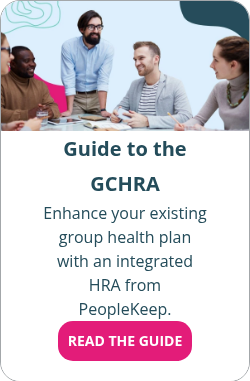Does an HRA require an HDHP?
By Elizabeth Walker on December 19, 2023 at 10:00 AM
When researching cost-effective health benefit solutions for your organization, you've probably come across health reimbursement arrangements (HRAs) and high deductible health plans (HDHPs).
When paired together, these two options can help employers save on healthcare costs. Still, employers may wonder how HRAs can work with group health insurance coverage and if using an HRA requires an HDHP.
In this article, we'll define HDHPs and HRAs. We'll also explain if you need an HDHP to implement an HRA at your organization.
Takeaways from this blog post:
- HRAs and HDHPs are cost-effective health benefit solutions that can help employers save on healthcare costs.
- HDHPs have lower monthly premiums and higher deductibles than standard halth insurance plans, and are often paired with HSAs.
- HRAs are flexible and allow employers to set a reimbursement allowance for qualified medical expenses, giving employees more control over their healthcare decisions. They don't require HDHPs.
What is a high deductible health plan?
An HDHP is a medical plan with lower monthly premiums and a higher deductible than standard health insurance plans. Insurance companies generally don’t cover out-of-pocket expenses until your employee meets their annual deductible or when they reach their out-of-pocket maximum.
For 2024, the Internal Revenue Service1 (IRS) classifies HDHP coverage as having a plan with a minimum deductible of $1,600 for single coverage and $3,200 for family coverage. An HDHP's maximum annual out-of-pocket medical expenses, including annual deductibles, copays, and coinsurance, can't be more than $8,050 for single coverage or $16,100 for family coverage.
Many organizations pair HDHPs with health savings accounts (HSAs). An HSA is a tax-advantaged employee-owned fund that helps your employees save money for out-of-pocket medical expenses on a pre-tax basis. However, employees can only set aside a limited amount of pre-tax dollars due to annual contribution limits.
While HSAs help offset the deductible and other medical expenses that come with HDHPs, you must offer a group HDHP, or participants must have an individual HSA-qualified HDHP, for you to make contributions to your employee's HSA. Additionally, HSAs are portable, meaning that HSA funds stay with your employees even if they leave the company.
The overall advantages of HDHPs are:
- Lower monthly premiums than PPO plans
- HSA eligibility with specific HSA-qualified HDHP plans
- Larger provider networks
If you choose an HDHP, your employees will still be 100% covered for preventive care from in-network providers before meeting their deductible due to Affordable Care Act (ACA) requirements. So, if you have a workforce that’s generally young and healthy, an HDHP is a good way for them to receive basic medical care while you save money overall.
What is a health reimbursement arrangement?
An HRA is an employer-funded health benefit used to reimburse employees for more than 200 qualified medical expenses. Depending on the type of HRA you offer, this can include expenses such as individual health insurance premiums.
Other HRA-eligible expenses include:
- Prescription drugs
- Over-the-counter medicine
- Dental expenses
- Vision expenses
- Preventative care
HRAs are a flexible form of health coverage because they allow employers to set an allowance amount that fits their budget while employees purchase the healthcare items and services that best suit their needs. Once they submit documentation for their eligible expense, employers reimburse them for the cost.
With HRAs, employers reimburse employees only after the employees incur an approved medical expense. This feature is beneficial for employers who want to retain control over their cash flow. Additionally, unused funds stay with the employer if the employee quits.
The overall advantages of HRAs are:
- Cost control by setting a monthly allowance
- Tax-free money for reimbursements
- More employee involvement in their own healthcare decisions
The two most popular stand-alone HRAs you can offer are the qualified small employer HRA (QSEHRA) and individual coverage HRA (ICHRA). Like HSAs, QSEHRAs come with annual limits for employer contributions. But ICHRAs don't. Many employers use a QSEHRA or an ICHRA as alternatives to traditional group health insurance coverage. Because you offer stand-alone HRAs instead of a group plan, they don’t require an HDHP.
A group coverage HRA (GCHRA), also known as an integrated HRA, is a tax-advantaged arrangement employers can pair with group health coverage to help employees pay for qualified health expenses and out-of-pocket costs that aren't fully covered by your traditional group health plan.
Does a GCHRA require an HDHP?
Unlike HSAs, you don't need an HDHP to use a GCHRA. You can supplement any group health insurance plan with a GCHRA.
If your traditional group health plan comes with annual rate hikes and premiums, but you don’t want to cancel it and switch to an HRA, then a GCHRA is for you. When you pair it with an HDHP, it can help keep your medical costs down while providing great employee benefits. This HRA can bridge the gap between offering traditional group health plan coverage and minimizing premium costs in these cases.
The overall advantages of combining an HDHP with a GCHRA are:
- Unique capabilities to set HRA deductibles, cost-sharing, and coinsurance
- Lower overall costs using an HDHP
- Offset employee out-of-pocket expenses with HRA funds
If you manage your GCHRA benefit with PeopleKeep's administration software, our HRA experts will handle documentation review and compliance for you so you can focus on running your business.
Conclusion
Specific HRAs only work with individual health insurance plans, but GCHRAs are special. You can use them with any type of group health insurance plan, and when paired with an HDHP, employers can save significantly on premiums and healthcare costs. This feature makes them a good option for employers offering a traditional group health plan to control costs.
Get started with a GCHRA today. Schedule a call with a personalized benefits advisor now!
This article was originally published on January 14, 2021. It was last updated on December 19, 2023.
Check out more resources
See these related articles

Choosing between a low or high deductible health plan
In this article, we’ll discuss the differences between an HDHP and an LDHP and which type of plan will work best for you based on your specific situation.

HRAs and W-2 annual reporting
Learn about HRA W-2 annual reporting requirements. Understand what employers need to include on employees' W-2 forms for HRA compliance.

Can HRAs reimburse long-term care premiums?
Find out if long-term care insurance premiums are reimbursable from an HRA. Learn the rules and eligibility for HRA-covered premium expenses.



